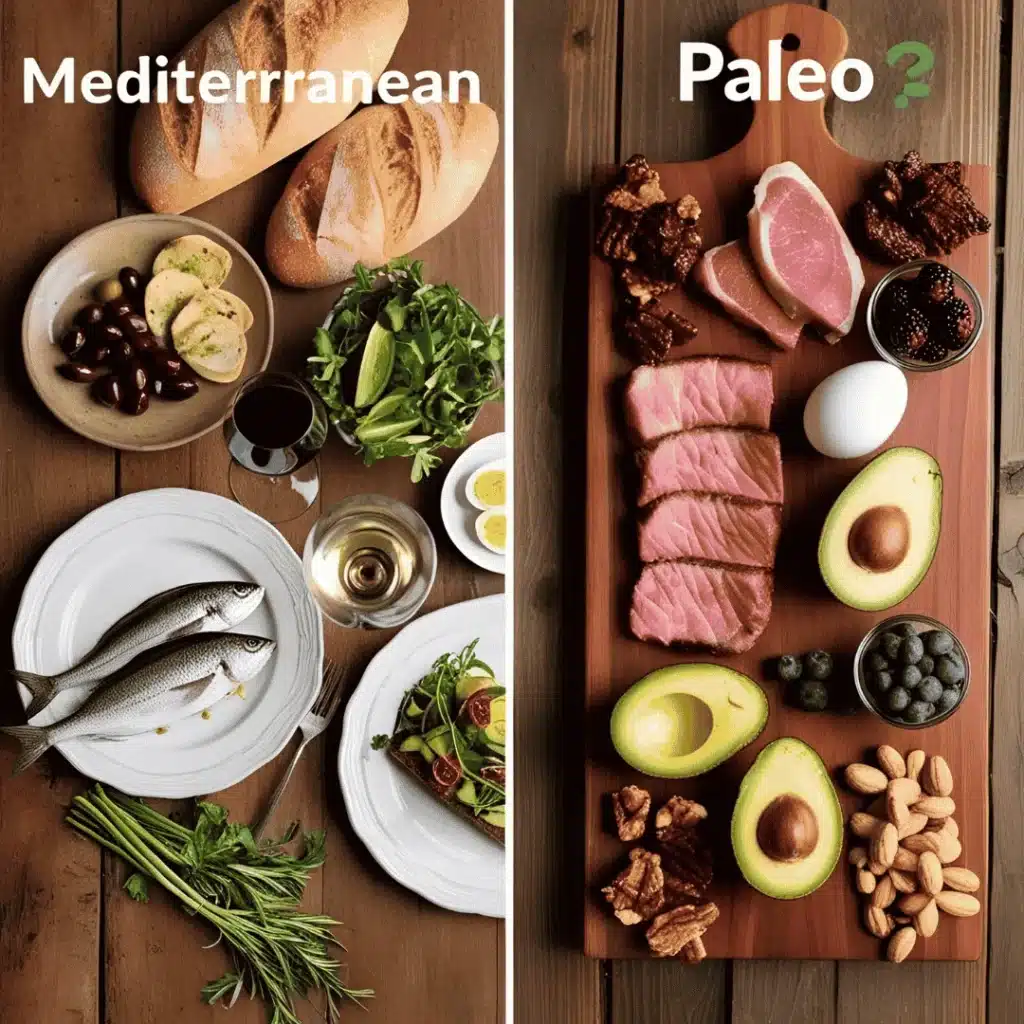Summary
So far, the Paleo diet has proven effective for some people managing diabetes, with clinical research suggesting better blood sugar control, insulin sensitivity, and lower HbA1c levels. Paleo helps stabilize blood glucose levels and supports metabolic health by focusing on wholesome, unprocessed foods like lean meats, low-glycemic vegetables, omega-3-laden fish, and healthy fats while eliminating grains, legumes, dairy, and refined sugars. Research also points to other benefits, such as reduced blood pressure, improved cholesterol profiles, and reduced body fat, critical components in diabetes care.
In addition to its blood sugar-promoting effects, the Paleo diet promotes cardiovascular health and sustainable weight loss, two significant factors in type 2 diabetes management. Participants often note decreased waist circumference and improved appetite control from the diet’s high protein and fat content. Initial fatigue and the risk of low blood sugar for those on medication can also be minimized with proper guidance, wellness checks, and monitoring. As with other considerable dietary modifications, it’s a good idea to check with a healthcare provider to find the right pathway for making this work and for sticking with it in the long run.
Key Takeaways
- Clinical studies show it can drastically lower HbA1c and improve glycated hemoglobin in those with diabetes.
- A paleo-based diet is thought to improve insulin sensitivity and decrease insulin resistance, which is essential for effectively managing diabetes.
- The diet’s reliance on lean meat, fatty acids, and healthy produce while avoiding processed foods and cereal shots was a boon for glycemic control.
- Dropping more flab led to several metabolic gains, including lower blood pressure, less body fat, and better cholesterol levels.
- There is a substantial body of literature on these participants who adhere to the Paleo diet, many of whom lose significant weight and waist circumference two key contributing factors to diabetes management.
Introduction
Research, however, suggests the Paleo diet can benefit people with diabetes in terms of glycemic control, insulin sensitivity, and cardiovascular health markers. Have you been managing your diabetes and trying to figure out whether the Paleo diet might work for you? You’re not alone. As diabetes becomes more common, many adopt ancestral diets for better blood sugar control. Positive outcomes say studies research has shown that a Paleolithic diet can result in:
- Significantly improved glycemic control with reduced HbA1c
- Improved insulin sensitivity
- Reduced blood pressure and triglycerides
- Important weight loss and decreased waist circumference
However, before you adopt this ancestral way of eating, it is important to understand how it works, its potential benefits, and key considerations. So, let’s investigate the evidence and science behind the Paleo diet and whether it’s right for you on your diabetes journey.

Core Components of a Diabetes-Friendly Paleo Diet
Paleo food includes natural food sources our ancestors depended on. Some elements of this ancestral model may require us to pay even more attention to stabilizing our blood sugars when we use them for diabetes management.
Foods to Include
A diabetes-friendly Paleo diet focuses on whole food choices and nutrients without compromising blood glucose levels. Lean meat sources, such as chicken, turkey, and grass-fed beef, provide protein without the extra saturated fat. Fresh produce, most importantly non-starchy vegetables, serves as the base for every meal, supplying fiber and micronutrients with little impact on blood sugar.
Wild-caught omega-3-rich fish, pasture-raised eggs, nuts, and seeds provide healthy fats that slow digestion and fend off spikes in blood sugar. You may also eat moderate amounts of berries and other tasty low-glycemic fruits that provide antioxidants while keeping carbohydrates in check.
Foods to Avoid
Following true Paleo principles means eliminating several food groups that can impact blood sugar management. All grains, including whole grains, are excluded as they weren’t part of our ancestral diet. Legumes, despite their nutritional benefits, are also avoided due to their high carbohydrate content and presence of antinutrients.
Dairy products, processed foods, and refined sugars have no place in a diabetes-friendly Paleo approach. These modern additions can cause rapid blood sugar fluctuations and inflammation. Industrial seed oils, artificial sweeteners, and preservatives are also eliminated to maintain the diet’s focus on natural, unprocessed ingredients.

Health Benefits Beyond Blood Sugar Control
Not only does the Paleo diet directly affect blood sugar levels, but it also works more holistically, helping people with diabetes significantly improve their overall health.
Cardiovascular Improvements
The Paleo diet can help improve heart health by addressing several cardiovascular risk factors. Eat Ancestor’s Way: Research shows the ancestral eating pattern reduces high blood pressure, a common problem for people with diabetes. The diet’s focus on lean proteins, healthy fats, and a bounty of vegetables naturally supports arterial function and promotes healthy cholesterol levels.
Removing processed foods and refined carbohydrates and adding omega-3-rich foods such as fish and nuts counteract metabolic syndrome, a group of conditions that are frequent companions of diabetes. Research has shown better blood vessel function and lower levels of inflammation markers in participants on the Paleo diet.
Weight Management Benefits
The Paleo diet has many benefits, but one of the most popular benefits is weight loss and a leaner body composition. Eating whole, nutrient-rich foods naturally leads to lower calorie consumption with the ongoing feeling of fullness. It allows people to attain and maintain a healthy weight without being hungry all the time.
The elimination of processed carbohydrates combined with high levels of protein proved more effective in reducing body fat percentage than conventional low-fat diets. Studies have found that individuals on a Paleolithic diet experienced more significant decreases in waist circumference and total body weight than those on traditional diabetic diets.
Its innate capacity to balance appetite hormones means you will never overeat and must maintain a long-term weight. This is excellent news for diabetics and folks with metabolic syndrome since controlling blood sugar and metabolic health is closely tied to weight maintenance.
Conclusion
So, as we’ve navigated the science-based evidence, the exciting news is that there is promising potential for diabetes management through improved blood sugar control and enhanced insulin sensitivity from the Paleo diet. The diet emphasizes whole foods, lean meats, and fresh produce all hallmarks of effective diabetes management while excluding processed foods and refined sugars that may disrupt blood glucose levels. Note the caveat here – transitioning to a Paleo diet isn’t necessarily easy and can take some work to get right, especially for people living with diabetes.
Before significantly changing your diet, please work with your healthcare provider to ensure this approach is right for you and your needs and medical history. Pay careful attention to your blood sugar during the transition, and continue to adjust your diabetes medications as directed by your health professional. Whether you are looking into Paleo to help manage diabetes from a lifestyle standpoint or just looking for possible general health benefits — the key to success with this way of eating (just like any eating plan) is an emphasis on establishing long-term, sustainable changes for blood sugar management that fit your lifestyle while maintaining a well-rounded diet that’s rich in nutrient-dense foods.
FAQs
1.Can I follow the Paleo diet if I’m taking diabetes medication?
And yes, the Paleo diet is compatible with diabetes medication. However, your healthcare provider must monitor you because your blood sugar levels could improve, requiring you to lower the dose of your medication. Frequent monitoring is also necessary for this change of diet.
2.How long does it take to see improvements in blood sugar levels on the Paleo diet?
Many people start seeing positive blood sugar level changes with a strict paleo diet in as little as 2-4 weeks. Exercise, medication, initial blood sugar levels, and diet plan compliance are all aspects that may lead to different results among individuals.
3.Are there any risks of hypoglycemia when following the Paleo diet for diabetes?
There is some risk of hypoglycemia, especially early in the adaptation phase. The lower amount of carbohydrates in the diet may have a marked effect on blood sugar levels. Regular blood glucose monitoring is essential, and fast-acting carbohydrates should be readily available.
4.Can I occasionally have cheat meals while following Paleo for diabetes management?
Though no plan is meant to be rigid, these occasional cheats should not throw you off the path toward blood sugar control and insulin sensitivity, which require a certain level of adherence to the numbers. For the first 30 days, at least, you want to be right in and see the benefits of diabetes management.
5.How does the Paleo diet compare to other diabetic diets in terms of effectiveness?
Research suggests that (especially when looking at overall compliance) the Paleo diet provides similar or even better results than the best traditional diabetic diets in improving insulin sensitivity and lowering hemoglobin A1C. It is effective for blood sugar management because it emphasizes whole foods and lower carbohydrate content.
6.What should I do if I experience fatigue during the initial weeks of the Paleo diet?
Fatigue in the beginning is common as your body adjusts to lower carbohydrates. Eat enough protein, drink lots of water, and possibly increase your healthy fat consumption. If fatigue continues for more than 2-3 weeks, get additional recommendations from your healthcare provider.












